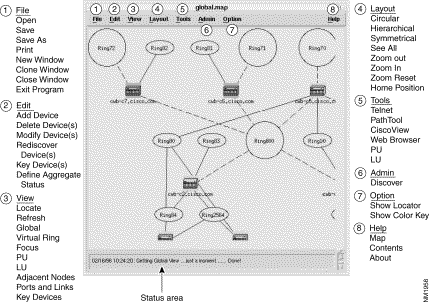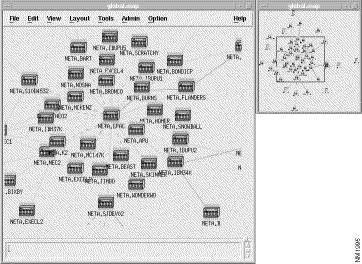|
|

CiscoWorks Blue Maps is a suite of applications for managing networks of Cisco routers that are enabled for remote source-route bridging (RSRB), data link switching (DLSw), or the Advanced Peer-to-Peer Networking (APPN) protocol.
This chapter includes the following major sections on CiscoWorks Blue Maps applications and features:
The RSRB, DLSw, and APPN Map applications have many features in common. Figure 1-1 shows the main window of the RSRB Map application. Not all options in Figure 1-1 appear in every Map application.

The main window consists of the following elements:
The Locator window, shown in Figure 1-2, is a navigational aid that shows your entire network and lets you control which portion of the network appears in the main window.

Table 1-1 lists the File menu options in all Map applications.
| Menu Option | Purpose |
|---|---|
Display the Map File Selector window from which you can do the following:
| |
Save the network map file that is currently displayed in the Map application main window. | |
Save As | Save the current network map file under a different name. |
Print the network map to a printer. | |
Create a new main window for the Map application. | |
Create an identical main window showing the network map displayed in the first window. Having an identical window is useful if you want to compare two different parts of your network on side-by-side maps or navigate to another map while keeping the current map. | |
Close Window | Close the main window for the Map application. |
Exit the Map application. |
Table 1-2 lists the Edit menu options available in all Map applications.
| Menu Option | Availability | Purpose |
|---|---|---|
RSRB, DLSw | Manually add a device to the Map database by specifying its name or IP address and its Read Community string. If the device is running RSRB or DLSw, then the device is added to the appropriate map display. | |
RSRB, DLSw | Delete selected devices from a network database. This also removes the device from the corresponding map. | |
RSRB, DLSw | Modify selected devices information by entering a new device name and read community string. | |
RSRB, DLSw | Query selected devices to update its information in the Sybase database and display on the network map. | |
Key Device(s) | DLSw | Specify key routers in your network. Key routers are those routers that are in close proximity to the host and are responsible for handling DLSw traffic between the host and other routers and devices in your network. |
Table 1-3 Lists the View menu options in Map applications.
| Menu Option | Availability | Purpose |
|---|---|---|
All Map applications | Locate a specific device in a network map by specifying its name or IP address. | |
RSRB, DLSw | Refresh the displayed network map in the main window with latest status of devices. | |
All Map applications | Display the global map. | |
RSRB | Present a view of a specified virtual ring and its peers. | |
RSRB, DLSw | Select View > Focus and specify the peer name of the device you want in focus view. | |
RSRB, DLSw | Query the status of a specified PU and its dependency. SNA View software must be installed on your mainframe and workstation. | |
RSRB, DLSw | Query the status of a specified LU and its dependency. SNA View software must be installed on your mainframe and workstation. | |
Adjacent Nodes | APPN | Display a subset of the APPN map showing the nodes that are just one hop away from a selected node. |
Ports and Links | APPN | Display the ports on a selected APPN node (such as Ethernet and Token Ring), plus the links from those ports to adjacent network nodes. |
Table 1-4 lists the ways you can view a map in the main window of a Maps application.
| Menu Option | Availability | Purpose |
|---|---|---|
All Maps | Display network devices in a circular format. | |
All Maps | Display network devices in a hierarchical format. | |
All Maps | Display network devices in a symmetrical format. | |
See All | All Maps | Display a view of the network map that shows all devices. |
All Maps | Provides a larger view of the network map. | |
All Maps | Display a close-up view of the network map. | |
Zoom Reset | All Maps | Reset to the default size. |
Home Position | All Maps | Reset the locator window to the upper left-hand corner of the map window. |
Table 1-5 lists the applications you can launch from the Tools menu in a Maps application.
| Menu Option | Purpose |
|---|---|
Telnet | Launch a Telnet application to let you log into a router. Click a router on the map, and select Telnet from the Tools menu. |
Launch the Path Tool application (that is part of your existing CiscoWorks installation), which enables you to view and analyze the path between two devices so that you can:
| |
Launch the CiscoView application (that is part of your existing CiscoWorks installation), which is a GUI-based device management application that provides dynamic status, statistics, and comprehensive configuration information for Cisco Systems' products. CiscoView allows you to display a graphical representation of each network device, display configuration and performance information, examine the status of interfaces, and perform minor troubleshooting tasks. For a list of Cisco devices that you can manage with this application, refer to the CiscoWorks Release Note or CiscoView Release Note. | |
Web Browser | Launch the web browser so that you can use the CiscoWorks Blue HTML interface, if installed. |
Available for all Maps applications if CiscoWorks Blue SNA View is installed on your mainframe and workstation. Launch the SNA View application which enables you to:
| |
PU | Enable you to view a list of PUs based on specified filter settings. SNA View must be configured on the system for RSRB or DLSw. |
LU | RSRB and DLSw: Enable you to view a list of LUs based on specified filter settings. APPN: When selected from the Tools menu, presents a list of all LUs in the network. When you select a node by pointing to it clicking the right mouse button:
For each LU, the information includes:
|
Table 1-6 explains the administrator-level functions you can perform with Map applications.
Table 1-7 lists the Option menu options in the Map applications.
| Menu Option | Purpose |
|---|---|
Show Color Key | Display or hides the color key at the bottom of the Maps window. |
Display or hide the Locator window with the Locator Square. |
Table 1-8 explains the Help option in all Map applications.
| Menu Option | Purpose |
|---|---|
Map | Display online help for the main map window for the Map application that is running. |
Contents | Launch the contents tab for the online help for the Maps and SNA View products. |
About | Display version and copyright information about the application. |
This section explains how to access the online help system.
Use the Maps help system to accomplish the following:
Map applications come with a HyperHelp viewer window that displays help topics.
You can get help by doing one of the following:
You can navigate help topics in the HyperHelp Viewer window in a variety of ways:
When you enter the desired characters in the text entry field at the top of this dialog box, the corresponding words appear in a list in the middle of the dialog box, and the related topics for those words are listed for display in the bottom portion of the box.
You can search for words that contain text strings that begin or end with, appear in, or contain exactly the characters that are typed.
![]()
![]()
![]()
![]()
![]()
![]()
![]()
![]()
Posted: Thu Aug 19 11:40:02 PDT 1999
Copyright 1989-1999©Cisco Systems Inc.